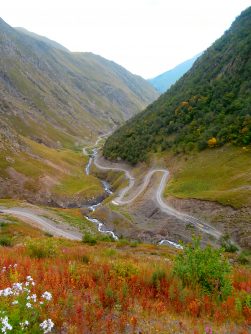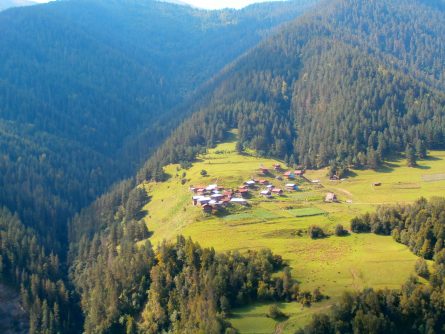Winnipeg to Omalo, Tusheti – an unusual journey
Winnipeg to Omalo, the primary own in Tusheti, is long but well worth it!

I like journeys; I like the feeling of movement, the unfolding landscapes and the frisson of excitement that comes with each corner turned. I do, however, have limits, and the forty-hour odyssey that took me from suburban Winnipeg, anodyne and comfortable to Omalo, raw and isolated, was an epic.
A cheery farewell at the Winnipeg airport, a normal flight to Chicago and ample time there to head into town and enjoy lunch and a gawk at the city’s ever-fascinating skyline started the journey well. I rather like Chicago; it is a “crunchy” city, unprepossessing, gorgeous with terrific people and an endless choice of things to do, places to wander and ample to eat and drink.
Thus fortified, I returned to O’Hare for the late evening, Lufthansa departure to Frankfurt. Here the primary benefit of swarms of frequent flyer points came to light as I settled into my bed in the First Class section of the aircraft; there were, in fact, three of us on the upper deck of the 747, none really interested in food, although I think we all prodded at the caviar before retiring for the night, and the eight-hour flight to Europe.
Arriving in Frankfurt, I headed to the lounge, showered and prepared to the next three legs of this journey.
Here is the primary drawback of swarms of points; the comfort of the premium cabins is often tempered by the requirement to travel on circuitous routes, and thus I found myself on an early evening flight to Venice, and quick transfer and off to Istanbul before heading to Tbilisi in the middle of the night. Exactly which night it now was, I was not entirely sure.
Landing in Tbilisi at 3.00am is odd; the airport is alive with flights from Munich, Warsaw, Rome, Minsk and all sorts of exotic locales, the place is heaving and the luggage carousels doing sterling service under the weight of the terrific assortment of “stuff” that folks seem to need to travel with.
Onwards. I met my friend Ia and our driver, and off we went on the eight hour run through the plains of Eastern Georgia before turning north toward Tusheti, a remote and inaccessible part of the country, nestled comfortably against the Chechnyan and Dagestani borders.
Now a word here about roads; in particular the vernacular that we attach to descriptions of roads and the comfort of travelling on top of them. Let it be said that Georgian roads are interesting; many well paved and rather pointlessly marked with white lines.
Potholes are relatively few in comparison with much of urban Canada, but as one distances oneself from Tbilisi, the surfaces become increasingly variable.

From Tbilisi to Alavani takes a couple of hours, and by this time little green men were starting to jump out at me, and I was happy that I wasn’t driving. Ia had thoughtfully brought a pillow for me, and I was wound up on the back seat reasoning that the Mitsubishi Delica that we were driving was created for Japanese, who are, as a race, considerably smaller (and presumably flexible) than I.
It is a fine van, and considerably more robust that first appears; I couldn’t help wondering if the water stain on the interior of the roof was a left over from the hundreds of Tsunami-soaked cars, and whether or not I would glow.
Beyond Alavani the road is limited to 4WD vehicles; and apparently bicycles, but they were possibly simply mad. The 70km stretch to Tusheti is an extraordinary road; rutted, potholed, narrow and pushing through some of the most extraordinary scenery one can imagine.
By now dawn had sprung, and as the sun came up each corner led to a new sharp intake of breath as the mountains of the Great Caucasus came into view. The road dragged itself up to the AbanoPass, at 3,000 metres, a high point and that morning swirling with mist and sheep. Over the pass, as the road drops into the Chebalaki River Valley, one really starts to understand the beauty of isolation.
It becomes quite obvious how the history and anthropology of the region is determined by geography, and it is this very geography that offers protection and possibility has allowed the communities to survive, and indeed thrive.
It has to be noted at this point, that this road was one chosen by the BBC to highlight is a series of the “World’s Most Dangerous Roads”!
By now I was confused. The pasteurised world or airports and aeroplanes had within five hours given way to a new century, and an entirely new world; as we dropped into the valley, and the first Tushetian villages of Shtrolta and Khiso came into view.

Attractive clusters of perhaps twenty houses lying together on a distant river bank and accessible only on horseback, they were the epitome of security. Cosy, attractive and utterly timeless the description that I had read about Tusheti “like Switzerland 100 years ago” seemed apt.
Communities that have been here since the dark and distant days some thousands of years ago. And, as I was to learn, still very traditional and held together with an interesting fabric woven from strands of religion, respect, strict social mores and a desire to continue a lifestyle that has been lost in so many places.
By now I was a bit tired, and must have lost my presence of mind as I muttered from my (by now) pretzel-shaped position on the back seat about the excitement that riding a horse up here would offer. I was clearly getting a touch hallucinatory, and it was with some little relief that we arrive at our wonderful guesthouse in Omalo, and popped like a constrained champagne cork from the van.
This was to be the most moving place that I have ever visited. But that is another story.
Winnipeg to Omalo had taken about forty hours, but is seemed that beyond that temporal measurement I had travelled back in time, and more importantly, I felt that somehow, the earth was moving a little more slowly.
